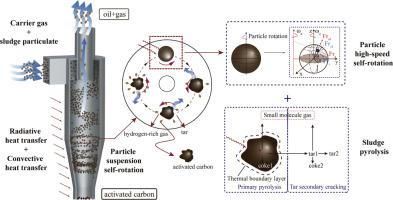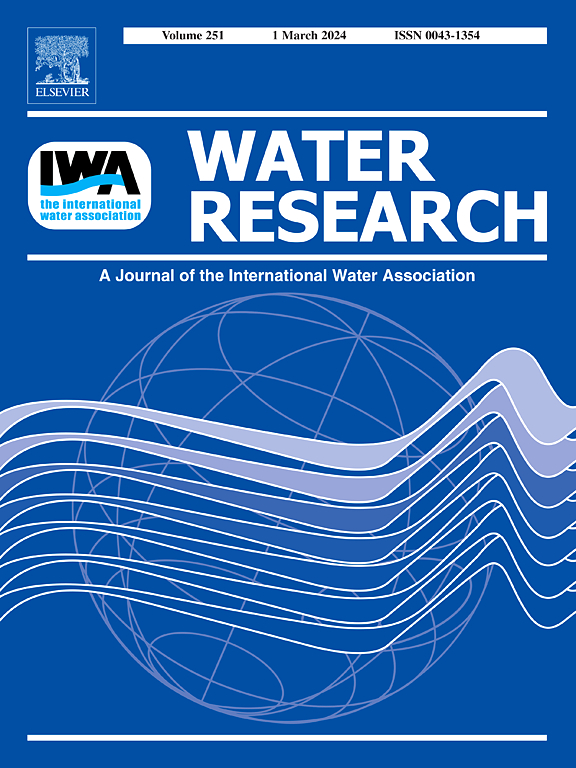Hydrogen production by suspension self-rotation enhanced pyrolysis of sludge particles in cyclone
IF 11.4
1区 环境科学与生态学
Q1 ENGINEERING, ENVIRONMENTAL
引用次数: 0
Abstract
The challenges faced by sludge pyrolysis units, including poor heat transfer efficiency and uneven heating of material groups, significantly hinder the green and low-carbon transformation and sustainable development of sludge treatment. The suspension self-rotation of sludge particles in a cyclone enhances particle heat transfer, thereby improving the pyrolysis process. In this study, we developed a novel method for sludge pyrolysis using Cyclone Suspension Self-Rotation Pyrolysis Reactor (CSSPR). Through numerical simulation and high-speed camera visualization, we analyzed the effects of cyclone cone angle, particle size, and inlet flow rate on particle suspension self-rotation. A systematic investigation was conducted into the mechanisms by which “particle suspension self-rotation” enhances “sludge particle pyrolysis”. Consequently, an effective method for utilizing hydrogen-rich gas produced by sludge suspension self-rotation pyrolysis was developed. The results showed that CSSPR with a 9° cone angle achieved optimal suspension autorotation efficiency. Under optimal conditions—sludge particle moisture content of 31.89% and particle suspension rotation rate of 100%, the hydrogen production per unit of sludge reached up to 265.78 mL/g, which is 1.3 times higher than that produced in a static state. Compared to traditional fixed-bed pyrolysis technology, CSSPR demonstrated superior pyrolysis performance, achieving a 155.78 mL/g higher hydrogen yield per unit of sludge. This study offers a novel approach to developing sludge resource pyrolysis technology, thereby providing an effective pathway for addressing climate change and advancing environmental governance.


求助全文
约1分钟内获得全文
求助全文
来源期刊

Water Research
环境科学-工程:环境
CiteScore
20.80
自引率
9.40%
发文量
1307
审稿时长
38 days
期刊介绍:
Water Research, along with its open access companion journal Water Research X, serves as a platform for publishing original research papers covering various aspects of the science and technology related to the anthropogenic water cycle, water quality, and its management worldwide. The audience targeted by the journal comprises biologists, chemical engineers, chemists, civil engineers, environmental engineers, limnologists, and microbiologists. The scope of the journal include:
•Treatment processes for water and wastewaters (municipal, agricultural, industrial, and on-site treatment), including resource recovery and residuals management;
•Urban hydrology including sewer systems, stormwater management, and green infrastructure;
•Drinking water treatment and distribution;
•Potable and non-potable water reuse;
•Sanitation, public health, and risk assessment;
•Anaerobic digestion, solid and hazardous waste management, including source characterization and the effects and control of leachates and gaseous emissions;
•Contaminants (chemical, microbial, anthropogenic particles such as nanoparticles or microplastics) and related water quality sensing, monitoring, fate, and assessment;
•Anthropogenic impacts on inland, tidal, coastal and urban waters, focusing on surface and ground waters, and point and non-point sources of pollution;
•Environmental restoration, linked to surface water, groundwater and groundwater remediation;
•Analysis of the interfaces between sediments and water, and between water and atmosphere, focusing specifically on anthropogenic impacts;
•Mathematical modelling, systems analysis, machine learning, and beneficial use of big data related to the anthropogenic water cycle;
•Socio-economic, policy, and regulations studies.
 求助内容:
求助内容: 应助结果提醒方式:
应助结果提醒方式:


